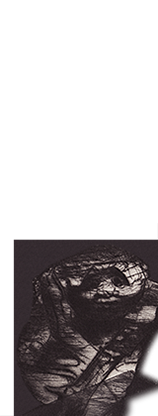Dado – The Chapel of St. Luke
In 1999, Dado takes over chapel of St. Luke in the leper-house of Saint Lazarus in Gisors, painting murals. The chapel, which is classified “monument historique”, was founded in 1210 by Jean de Gisors. It has a ground area of 110 m² and is located west of the city. Saint Lazarus was venerated as a patron saint of lepers and Saint Luke as a patron saint of doctors but also of painters…
Chapel virtual tour
Photo credit and production: Arnaud Frich for Ville de Gisors.
Reproduction Prohibited.
∗
∗ ∗
The Secret Meeting (Le conciliabule) (18 min. 56 sec.)
A film by Gisèle and Luc Meichler
© LGM, 2002
Sale off the DVD: LGM (lgm.meichler@free.fr)
The wall paintings by Dado at the chapel of St. Luke in the leper-house at Saint-Lazare (Gisors, France) are filmed to a text by Claude Louis-Combet.
“The Secret Meeting is to emerge from a verbal incarnation of Dado’s phantasmagoric figures by poet Claude Louis-Combet. Enlivened with tricks of language – conflicts, pacts, plots, tournaments, mockery, whispers, – it forms a tortuous dramaturgy, which, set in the chapel of an old lazar-house in Gisors, resounds to echoes that remain cruelly topical.” (Gisèle and Luc Meichler, LGM)
∗
∗ ∗
Conversation between Dado
and his daughter, Amarante,
concerning the St. Luke chapel
Click on the images to enlarge them
(large and extra large sizes)
❧
Fullscreen
slideshow
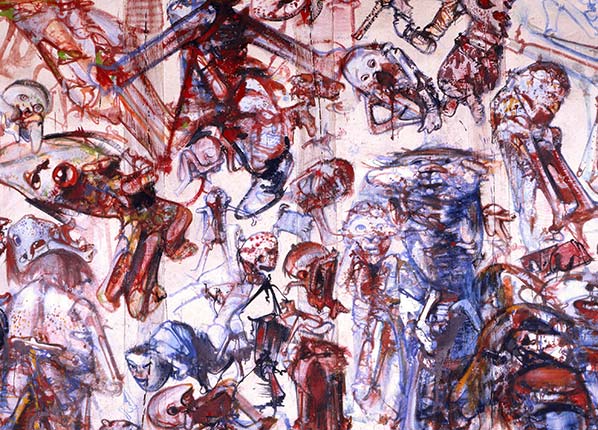
Amarante: Why the chapel? Why did the place attract you particularly?
Dado: It is all the same a building I have known by sight, from the outside, it should be said, for some forty years. I don’t go past it every day, but I noticed the splendid Gothic archway on the porch forty years ago. The chapel, at that time, was in very poor condition. And it was used as a home for homeless people. They’d made holes in the wall. There were always traces of human presence.
All in all, it was a den of outsiders…
Yes. That’s it. In fact, it has never lost its true vocation. Perhaps me too, I belong to this illustrious brotherhood, it’s possible… If that’s true, I’d be most gratified. Restored a few years ago the chapel was completely uninhabited – before I began my paintings.
When did the restoration finish exactly?
I’m not really one for dates, but it must have been finished some two or three years ago, the restoration… And it lasted at least two years. It was very long, they took down the rafters and put the roof back up afterwards.
And, curiously, now, in this chapel, there’s another presence, in addition to mine and the many figures one sees, quivering, there, on the wall – I believe. The avowed aim was that they should tremble, that they should quiver, that they move. Normally there’s no-one once I slam the door and turn the key… But, here, there is someone. Who? An owl. How she got in is a mystery. In any case, screech owl lives there, because I keep finding regurgitated pellets.
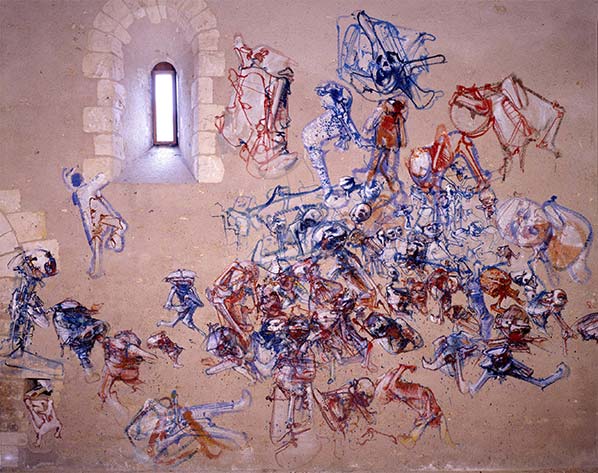
How would you characterize the links between the chapel and Les Orpellières ¹?
It was at Les Orpellières that the business with the chapel started. Why? Because I’m hardly someone who keeps his mouth shut, I’m rather talkative, and so I chatted to those around me, here, in Gisors, about Les Orpellières, to friends of your mother’s, and they said to one another: “And what if Dado did something for us?” and that’s when they thought of the chapel… so the chapel, is, for a substantial part, a second self-proclaimed commission.
How are Les Orpellières and the chapel “self-proclaimed commissions”?
Because these two pieces, especially the chapel, were made with purely verbal authorization and agreement. It was at Les Orpellières that it began to take form. André Gélis ² sent me a letter, in which my name was mentioned, and which said that the site was to be preserved. But Les Orpellières had been in existence for almost ten years! And this existence was no easy ride, as the four openings hadn’t been closed, and three of them are enormous, to the side whence the wind blows for most of the time.
Yes, unfortunately! Exposing them to the action of the spray, and at the same time condemning them to being temporary, unsubstantial. This is not at all the case with the chapel, which, on the contrary, exudes a kind of permanence…
Yes, and for my two self-proclaimed orders, I was the guest, at Les Orpellières, of a winegrower who had shut up shop in 1950; at the chapel, I stayed with an apostle, which was already much more… smart. So probably Luke the Apostle’s hospitality had something to do with it. I really don’t think I’m after some kind of conversion. St. Luke looked after those in suffering and that greatly touches me. And then, it’s true, he is the patron of doctors and of painters. There’s a famous Italian painting showing St. Luke is painting a portrait of the Virgin. It’s nice, a bit naïve.
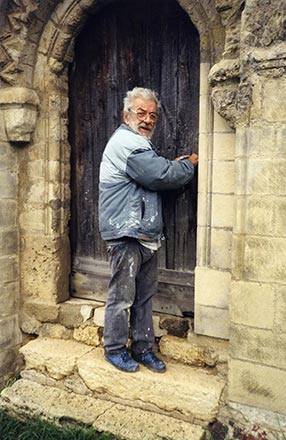
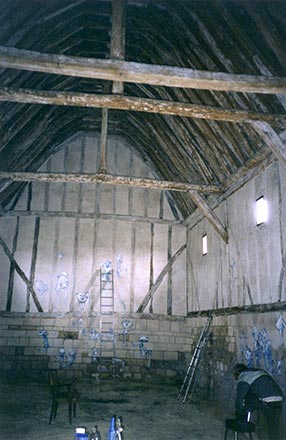
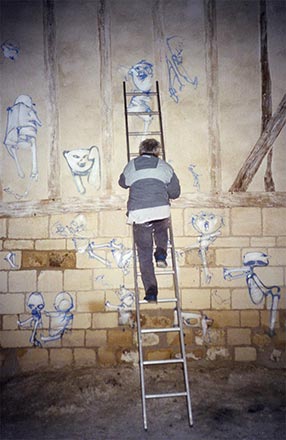
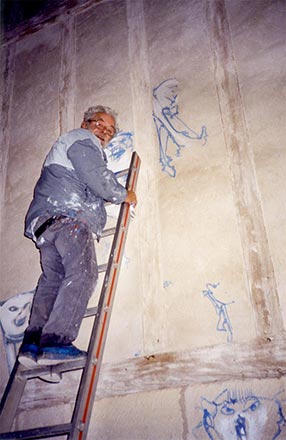
In fact, all the frescos of the chapel are elaborate and very constructed. And I remember very well that at the beginning, you wanted to use only white and blue for the figures…
Yes, quite right…
So why did you later go in for…
Color? I am pleased you remind me of that. Because in using white and blue, I my idea was to do something as astonishingly beautiful as the mosque at Pristina, that I’d visited with your sister Yanitza. The dome is just blue and white, and yet, in the middle, at the summit, there’s a wine-red rosette, red, blood-red. It’s very curious this association, that I’d associated the mosque at Pristina with the chapel of St. Luke. And why not.
But that can’t be innocent!
Nothing is innocent, especially not artists!
So you wanted to revive your painting, by using only two colors, something which you seldom did?
I’ve nevertheless done some monochrome pictures! It’s very relaxing, it’s an ancient technique that dates back to the Renaissance, and even before. It’s called grisaille. My first pictures were monochrome, blue.
I’m not a fan of color. In painting, what always interests me the most is the architecture of the picture and the form. Sometimes, I wonder why I like such and such a painter. To name one, Balthus, who has just passed away. Some find it overcooked. I say it’s not, I think that Balthus was an architect and a mason of painting. These are paintings built of stone, but on very strong foundations. It’s a really intricate painting and that I like.
There are, in spite of everything, a few similarities with what you do, aren’t there? Me, I’ve seen the various stages…
Yes, but then, when I look at the chapel, I realize that what I have just said, about the painter architect and mason, me, I’m an architect and a mason too, but my constructions are jerry-built! A few moments ago, I tried to ennoble the term, saying that my figures quiver. But it was this mobile aspect that interested me!
It is a construction in danger…
That’s it, in suspension. They are thrown out, like… In India, I saw people who, to make fuel, chuck cow dung on the walls in bright sunlight.
There, this is indeed exactly the impression one has; the figures are expelled, yet, at the same time, as if hanging in space…
Yes, and why? Because each one of these characters – I haven’t dared count them, it would take far too much time – also possesses weight. They are, one cannot say “highly organic,” but quite simply, organic. So these figures have weight, something like, at first sight, I don’t know, 30, 15, 12 kg, the weight of an eight-year-old child, and of an oldster, too… There are adults and young humanoids, cohabiting. Then, as I was doing the frescos, I said to myself: “But, shit, I’m a failed playwright!” Because, in fact, they’re all telling us something, but I don’t know what… Or else they’re exhibiting their innards…
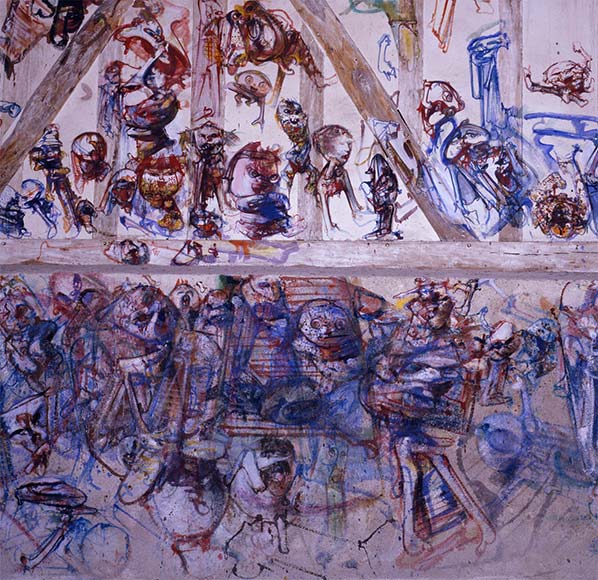
It’s perhaps the resurrection of the lepers, too?
Sure.
It’s perhaps not innocent to have chosen a chapel that once belonged to a lazar-house either…
But do I have the ability to resurrect lepers, then?
To what degree does your work in the chapel influence you in your work today?
Ah, I didn’t come out of doing the chapel of St. Luke unscathed! Too true, my recent work’s completely changed. It’s received, or lost, a lot blood, I’m not sure which.
But precisely how would you describe the work you’re doing now?
My doors, with their vertical ranks of wooden boards, they’re fallout from the chapel, of course. They were gasps of oxygen compared with my four meter by two pictures! One of them even preserves marks of Virginia creeper that I deliberately didn’t remove. It is a kind of tribute to Virginia creeper, and of course, to the lepers – about whom Italo Calvino writes in the splendid book I’m reading at the moment ³.
If you want, in a meal, the main dish would be the chapel, and my painting has sort of become a postprandial or an appetizer. Aspects of the chapel are, if not overloaded, then at least sated, stuffed to the gunwales.
And the chapel has more chance of eternity than Les Orpellières!
Technically already, it’s far more solid, stronger than Les Orpellières, because I used very good quality paint. And I devoted much more time, in terms of working days and hours, because it’s closer to the house where we live. While in Sérignan, I stayed just two or three days there, sometimes four. And Les Orpellières are nevertheless twice the size of the chapel, it’s one monster surface!
Indeed, they are two places that one might term diametrically opposed…
And the chapel is also the exact antipodes of Les Orpellières, because at Les Orpellières one hears nobody, one hears the birds, and it’s an entirely open space.
Whereas the chapel is a completely enclosed space…
That’s it. And assailed by cars one hears driving by!
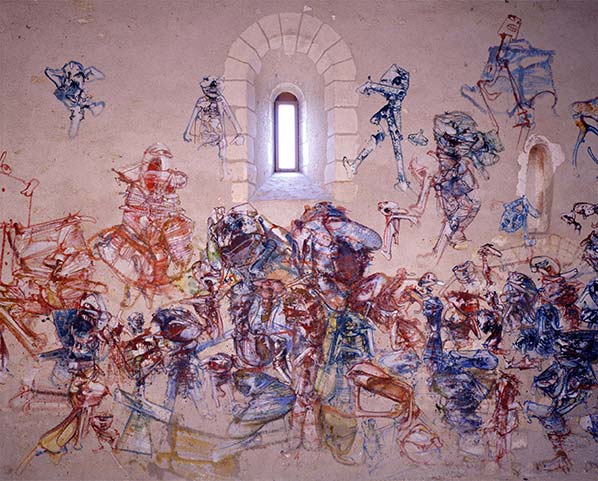
The light in the chapel appears to me of a different order to that in Les Orpellières. It’s a rather wan light, really…
Yes, and then the light in the Vexin too is my light by adoption. It is that of my land and the language in which we are communicating at the moment. It’s the light… I should say that I know the light better, if, however, one day one might know light; it’s funny thing, light. Light is relative, it changes all the time, because there’s the movement of the stars, that means it’s never fixed. That’s what gets me in electricity! Here, light is saved due to the canted Romanesque windows that result in an avalanche of light. You see, light, one could say it glides…
Yes, absolutely. But is it exactly because of this light that you used yellow, red, etc.?
Yes, of course! It’s the space, dimensions, the quality of the light, or, I should say, its ferocity. On sunny days, when I’m hard at it with the door open, it’s very tough. Because the media’s not particularly hospitable. Painting on canvas is all the same an obstacle race… a luxury craft: prepared canvases, marble brushes, paint, all that.
Yes, true, at the chapel you are confronted by bare walls!
I think that it was there that I kind of found my vocation, not as a tagger, if you like, but all this does smack of graffiti somewhat. As for the support, all I ask is that it doesn’t move, that’s all. But if it’s porous, rough, or even holed, that doesn’t worry me!
On the contrary, eh?
On the contrary…, if there are, for example, hollows, well these hollows can become part of a figure’s body.
An existing relief that you appropriate…
That’s it. And then, obviously, there’s also that I’ve started… It’s odd – as I was telling somebody the other day – the beginning of the chapel coincided with the book you gave me on the Chauvet ⁴ caves. Those superimposed rhinos…
That comparison also stems from the irregularity of the support?
Yes! You know I’ve visited prehistoric caves: Font-de-Gaume, in the Dordogne, and Pech-Merle too that I visited with your brother, Malcolm. In the Tassili also, I saw prehistoric paintings, more recent ones, but in the end, these things interested me and still do.
Did the difficulties posed by the support also act as a spur when it came to painting the doors?
Yes, but I had also done the series of the Sextons on hardboard, a very smooth material, utterly unlike the chapel’s rugged walls. A kind of game of complicity arises between the artist and the support, it’s the support that reveals the image, like a skin eruption.
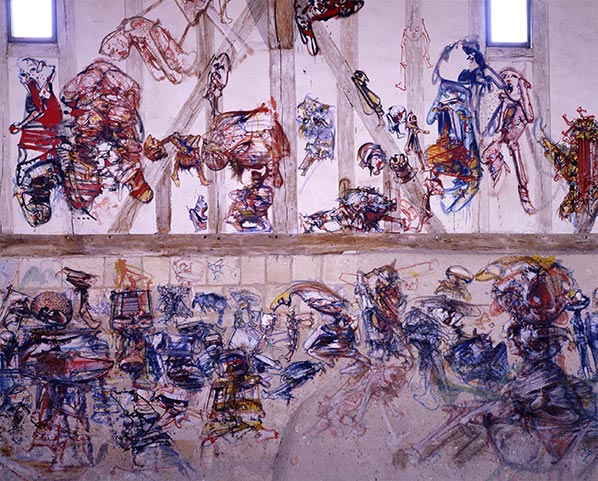
What are your short-term projects for the chapel? For example, are you planning techno music concerts in this space?
Why not? But I know what would go down really well at the chapel: quite simply, charity sales for lepers. It’s blindingly obvious. My idea is to sell St. Luke cider here or in Paris. Cornette de Saint-Cyr [auctioneers] will help me sell the bottles and the money will go to Madagascar, to a leper village, to drill a well. We might ask some artist friends… as was done for James G. ⁵. One could sell a few artists’ prints here.
So, in your work, there’s always a link to the past. Finally, lepers are always with us, but elsewhere?
Yes. But I heard the other day that there are a few lepers in Paris, being looked after in Saint-Louis Hospital. I don’t know where they come from. Another idea I had was to re-lay the chapel floor. But it’s too complicated administratively. In fact, it’s an archaeological site, there are several graves, under that sort of cement shell, which is relatively light…
St. Luke chapel, Gisors, 20 October 2001.
Translated from French by D. Radzinowicz.
2. André Gélis was mayor of Sérignan from 1989 to 2008.
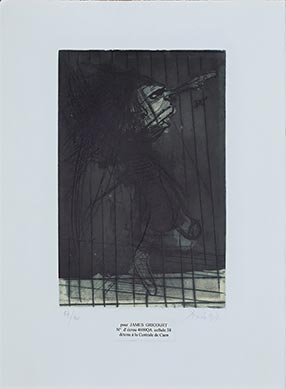
(38 × 28,5 cm).
3. It was Le Vicomte pourfendu, (French translation by Juliette Bertrand), Paris: Le Livre de poche, 1982 (The Cloven Viscount [tr. Archibald Colquhoun], New York: William Collins Sons & Co., 1962.)
4. This was the first text published after the very recent discovery of the cave mentioned (Jean-Marie Chauvet, Eliette Brunel Deschamps, and Christian Hillaire, La Grotte Chauvet, Paris: Le Seuil, 1995).
5. In 1997, Dado suggested to some artist friends (among them, Erró, Klasen, Guyomard and Rancillac) that they exchange one of their works for an engraving he had made for James G., a man once imprisoned for a hold-up, so he might benefit from a modest collection of contemporary art on coming out of jail.
